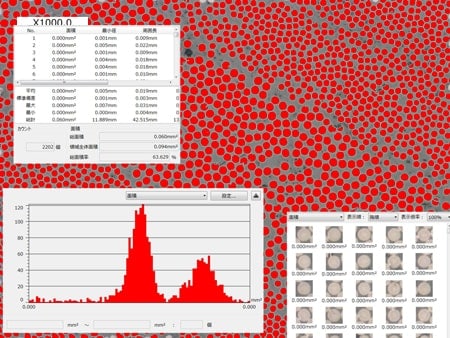Observation and Measurement of Carbon Fibres Using Digital Microscopes
Carbon fibre materials are lighter and stronger than iron and concrete and are used in various products in the aerospace and industrial fields as well as sports equipment. This section introduces examples of observation and measurement of carbon fibres using digital microscopes.

- What is Carbon Fibre?
- What is CFRP?
- Carbon Fibre Application Examples
- Carbon Fibre Observation and Measurement Examples Using Digital Microscopes
What is Carbon Fibre?
Carbon fibres are manufactured by burning acrylic fibres (polyacrylonitrile fibres), called the polyacrylonitrile (PAN) precursor, at high temperatures of approximately 1000°C. PAN precursors have diameters of 5 to 15 micrometres, around a tenth of a human hair. However, when compared to iron, their tensile strength is approximately 10 times higher, their density (mass per volume) is approximately one quarter, and their specific strength (strength per weight) is approximately 40 times higher. These materials provide both high levels of strength (difficult to break) as well as high levels of elastic modulus (difficult to deform).
What is CFRP?
CFRP stands for carbon fibre reinforced plastic, a type of plastic reinforced with carbon fibres.
FRPs are composite materials made by combining two or more materials. High rigidity and high strength are created by adding fibres to a base plastic as reinforcement. FRPs to which carbon fibres are added as the reinforcement are called carbon-fibre-reinforced plastics (CFRPs). These materials are characterised by conductivity, heat resistance, low thermal expansion properties, self-lubricating properties, and radiolucency in addition to high rigidity and high strength.
CFRPs have exceptional characteristics, but are more expensive than glass-fibre reinforced plastics (GFRPs).
These materials also have disadvantages. For example, they are difficult to process, easily darken, and fibre shapes remain on their surfaces.
Carbon Fibre Application Examples
Carbon fibre is used in a wide variety of industries. This section introduces some major applications.
- Automobiles, motorbikes
- Application: Roofs, spoilers, seat frames, wheels, muffler covers, body frames
- Aerospace industry
- Application: Rocket components and artificial satellites
- Airline industry
- Application: Aircraft bodies, helicopter blades
- Railroad
- Application: Train bodies, bogies
- Industrial machinery
- Application: Robot parts, conveying equipment hands, arms, and frames
- Electric appliances
- Application: Housings, including PC housings and smartphone covers
- Commodities
- Application: Frames of glasses and sunglasses, helmets
- Pressure vessels
- Application: Compressed natural gas (CNG) tanks, hydrogen tanks, oxygen cylinders for fire fighting
- Medical equipment
- Application: Radiographic equipment tables, X-ray film cassettes
- Social welfare, nursing care
- Application: Wheelchairs, prosthetic legs, assistive suits
- Sports industry
- Application: Golf club shafts, tennis rackets, bicycle frames
- Leisure industry
- Application: Fishing rods, yachts, cruisers, skis, snowboards
Carbon Fibre Observation and Measurement Examples Using Digital Microscopes
These are the latest examples of observation and measurement of carbon fibres using KEYENCE’s VHX Series 4K Digital Microscope.


A wide area can be observed at high resolution using the image stitching function.

Optical Shadow Effect Mode image

Optical Shadow Effect Mode + colour image






